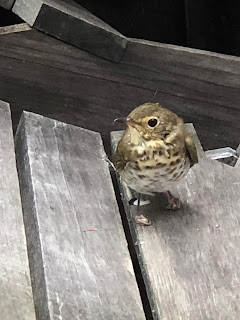Please advise editor at nelsonpoirier435@gmail.com if any errors are noted in wording or
photo labeling.
For more information on Nature Moncton, check into the website at www.naturemoncton.com
For more information on Nature Moncton, check into the website at www.naturemoncton.com
Transcript by: Louise Nichols nicholsl@eastlink.ca
To respond by e-mail, please address
your message to the information line editor nelsonpoirier435@gmail.com.
** Lois Budd got a great photo of a
juvenile YELLOW-CROWNED
NIGHT-HERON [Bihoreau violacé] while
birding on Saturday. This is not a New
Brunswick breeding bird and is not commonly seen in New Brunswick, especially a
juvenile.
Lois located it at Latitude
N4574949 Longitude W64491890’, Lower Rockport Road. Lois was
in Sackville and took 106 to go home, sign said 935 and headed that way.
After several Km and then onto a dirt road she passed the road to
Dorchester Rte. 935 and kept going straight. She came to a marshy area
on the right before a bridge and there it was. Seemed quite content so
may stay for a bit.
A very special find!.
** Jane LeBlanc has a very diverse
natural yard of plants in St. Martins, complete with a lily pond that attracts
lots of Mother Nature’s community. On
Saturday, an ATLANTIS FRITILLARY [Argynne de l’Atlantique] dropped by for
Purple Coneflower; a WHITE ADMIRAL BUTTERFLY [Amiral] came in for the Joe
Pyeweed; and when the light was just right, she could photograph a YELLOW-SPOTTED SALAMANDER
[Salamandre maculée] tadpole
in the lily pond.
** Louise Richard had a bird window
strike at their Acadieville cabin. The
size of the bird was not indicated, but in consultation with Gilles Belliveau,
he felt the buffy eye ring and lores with markings on the chest fit with SWAINSON'S THRUSH [Grive
à dos olive]. Hopefully, it recovered to continue on its
mission. This once common thrush has
declined in number.
** More colourful caterpillars are
being noted. Annegret Lamure spotted a WHITE-MARKED
TUSSUCK MOTH caterpillar enjoying munching on a maple leaf in her yard.
** Aldo Dorio sends a photo of GREATER YELLOWLEGS [Grand
Chevalier] that
are so common at the moment and will be in no rush to leave. Note the longer bill at one and a half head
lengths, and heavier set bill than the Lesser Yellowlegs, and also the slight
downcurved tip to the bill. He also
photographed JEWELWEED in bloom which is a migrating hummingbird favourite due
to its very high fructose nectar. It
also gets the common name “Touch-me-not,” as when the seed pods mature, they
can spring open suddenly to expel seeds, especially when handled.
** While visiting St. Martins on
Friday, we were able to see what has been given the name Anvil Rock, a rock
formation with trees on top similar to the formations at Hopewell Cape. Jane LeBlanc comments that when she moved to
the area 40 years ago, the top of it was attached to the cliff. They actually heard the rock crash, but
didn’t realize until after what the noise had been.
** Along the Fundy Trail Parkway, the
relatively small island Isle Haute can be seen out on the Bay of Fundy. This island has a lot of historical stories
of humans visiting the island. I was
able to get a photo but fog limited clarity.
** HIMALAYAN BALSAM is a common plant
in the Saint John area, and it is thought it was introduced by ships dumping
ballast. It has spread and it is quite
happily blooming at some sites at St. Martins at the moment. They grow in colonies and can grow quite tall
with attractive blooms. Some photos are attached. I have noted one large tall plant at
Bell/Wilson Marsh.
** The flower garden at the Fundy Park
Interpretive Centre has several Swamp Milkweed plants. MONARCH BUTTERFLIES [Monarque] have found it
and several chrysalids were noted. They
were all attached to a clump of ferns approximately 10 feet away from the
milkweed patch. Another chrysalis was
attached to the deck. A photo is
attached. Jim Edsall thought that it was
either a QUESTION MARK BUTTERLY [Polygone à queue violacée] or a MOURNING CLOAK BUTTERFLY [Morio]
pupal stage. If that is correct, an
adult butterfly will emerge this fall and overwinter as an adult.
** RED OSIER DOGWOOD is a very common
shrub that is sporting its clumps of white berries at the moment. When the shrubs lose their leaves in the
fall, the bright red stems are notable.
nelsonpoirier435@gmail.com
Nelson Poirier,
Nature Moncton

YELLOW-CROWNED NIGHT-HERON(JUVENILE). AUG 15, 2020. LOIS BUDD
YELLOW-CROWNED NIGHT-HERON(JUVENILE). AUG 15, 2020. LOIS BUDD
YELLOW-CROWNED NIGHT-HERON(JUVENILE). AUG 15, 2020. LOIS BUDD
SWAINSON'S THRUSH. AUG 15, 2020. LOUISE RICHARD
SWAINSON'S THRUSH. AUG 15, 2020. LOUISE RICHARD
SWAINSON'S THRUSH. AUG 15, 2020. LOUISE RICHARD
GREATER YELLOWLEGS. AUG 15, 2020. ALDO DORIO
ATLANTIS FRITILLARY AUG. 15, 2020. JANE LEBLANC
WHITE ADMIRAL BUTTERFLY. AUG. 15, 2020. JANE LEBLANC
CHRYSALIS OF EITHER MOURNING CLOAK OR QUESTION MARK BUTTERFLY (SUSPECTED) AUG 14, 2020. NELSON POIRIER
MONARCH BUTTERFLY CHRYSALIS. AUG 14, 2020. NELSON POIRIER
MONARCH BUTTERFLY CHRYSALIS. AUG 14, 2020. NELSON POIRIER
WHITE-MARKED TUSSOCK MOTH CATERPILLAR. AUG 15, 2020. ANNEGRET LAMURE
YELLOW SPOTTED SALAMANDER TADPOLE. AUG. 15, 2020. JANE LEBLANC
JEWEL WEED. AUG 15, 2020. ALDO DORIO
HIMALAYAN BALSAM. AUG 14, 2020. NELSON POIRIER
HIMALAYAN BALSAM. AUG 14, 2020. NELSON POIRIER
ANVIL ROCK. AUG 15, 2020. NELSON POIRIER
ISLE HAUTE. AUG 14, 2020. NELSON POIRIER
RED-OSIER DOGWOOD BERRIES. AUG 12, 2020. NELSON POIRIER



















No comments:
Post a Comment